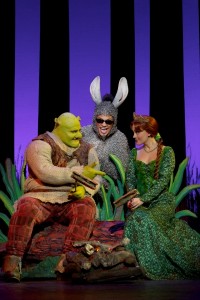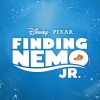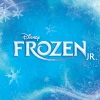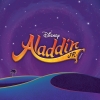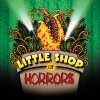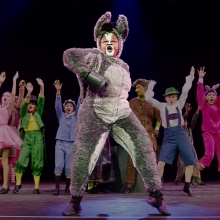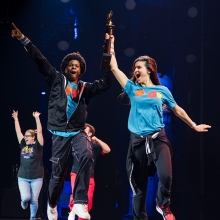Filichia Features: Shrek, Jr.: The Story of His Life
Filichia Features: Shrek, Jr.: The Story of His Life
Lukas Poost as Shrek, Andre Jordan as Donkey and Liz Shivener as Princess Fiona in Shrek THE MUSICAL 2011 – 2012 national tour. Photo by Joan Marcus.
Many schools and after-school programs that have been “going green” environmentally are about to go green theatrically, too.
For that lovable green ogre known as Shrek, the subject of a 2008 Broadway musical, has now given birth to the development of Shrek Jr.
A pilot production / staged reading last week of Shrek Jr. at The 52nd Street Project in New York City run by iTheatrics showed that it’s not only an ideal show for kids but that it may also be THE ideal show for kids.
The reason is not because an inordinate number of kids saw the musical on Broadway – let alone endlessly watched the DVD of the 2001 DreamWorks film.
The real reason: if there’s one thing kids know about, it’s fairy tales. They’ve heard them almost literally from Day One. And Shrek, Jr. has wisely included the fanciful characters from Fairy Tale’s Greatest Hits: Humpty Dumpty, Peter Pan, Pinocchio, Red Riding Hood’s Wolf, Sugar Plum Fairies, The Three Bears, The Three Little Pigs, The Ugly Duckling, The White Rabbit and The Wicked Witch of the West (or Elphaba, if you will).
And there’s another one that wasn’t in the Broadway show: the Gingerbread Man. There, he was a mere puppet; here he’s played by a real boy who’s threatened with extinction by tongs and a spatula.
Students from the pilot production of Shrek Jr
You’ll find that your students will already have a leg up on how to play these e fairy tale characters, because they've seen them, heard about them and – perhaps most important of all – thought about them all their lives.
Granted, these are not the biggest roles in the show. Still, kids cast in these parts will feel empowered in a way that they wouldn’t in other subordinate roles. There’s a big different between “I’m playing a boy in Oliver” and “I’m playing Pinocchio!”
These fairy tale characters are nice consolation prizes to kids who had their hearts set on playing the two leads: Shrek the Ogre -- whose lack of looks makes people dislike him at first sight – and Princess Fiona, who is waiting to be “rescued by my true love." She’s, aghast when an ogre shows up to do the job, but in time she and we will see that her true love did indeed rescue her.
Then there are two plum supporting roles: the loquacious Donkey -- who has an opinion or advice to dispense at every given minute -- and the evil Lord Farquaad who can only become king if he marries someone as beautiful as, say, Princess Fiona. Little does he and we know that Fiona is beautiful by day, but turns into an ogre by night. Oh, those fairy-tale spells!
Of course, the question of how much to make a child look like the film and stage Shrek is an issue. Last January, when I talked to Brian D’Arcy James -- who played the role on Broadway for a solid year – he told me that he loved being in that green fat suit even though it obscured his body and face. Somehow, that costume freed him to sink into the character’s skin.
You and your Shrek may feel differently. Here at the 52nd Street project, the lad playing Shrek simply had a headpiece with green ears, and we were asked to imagine that he was an ogre. It worked. So would green facial makeup.
Lord Farquaad was atypically cast with a young girl, who did the role proud. To establish that she was playing a male, a whimsical mustache was drawn under her nose – the thin, curly-cue kind that effete Frenchmen favored during the Renaissance. So if you feel you don’t have enough boys to do Shrek, this production offered a nice alternative.
No attempt was made to put the lass into a contraption to make her shorter or mask her legs, as poor Christopher Sieber had to endure for 441 performances. It really isn’t necessary, and I daresay that few if any missed the device.
Shrek, Jr. revels in anachronism, for which kids are the target audience. Students who already know their way around musicals will adore when Lord Farquaad insists "And no one's going to bring me-e-e-e downnnn!" After Donkey brags about his sense of direction by saying, "I'm like a GPS with fur,” kids will chortle and say “They didn’t have that then!” These may not be laughs that are commensurate with Shavian wit, but they will tickle kids’ fancies.
Speaking of that Donkey: has there ever been a drama program that doesn’t have a kid who’s on the hyperactive side? Here’s your chance to harness the student’s energy by casting him or her as Shrek’s too-enthusiastic, always on-the-run, continually-talking and occasionally braying sidekick.
Shrek also has a few cameo moments in which kids can shine. One of them involves a rooster whose job it is to announce the new day with a loud “Cock-a-doodle-doo.” The lad here at 52nd Street took his assignment very seriously, and the audience loved that he delivered the crow with the importance of the Gettysburg Address.
As much fun as the kids will have in singing Jeanine Tesori’s melodies and David Lindsay-Abaire’s lyrics, they’ll also come face-to-face with issues that are worth discussing before rehearsals start.
The show begins with Shrek’s parents sending him into the world at the age of seven. Some of your kids may now be that age, and plenty of others won’t be far from it. Ask a result, ask them “So how would you feel if your parents threw you out of the house today as Shrek’s folks did?” When the kids get home that night, they just might be a little nicer to mom(s) and/or dad(s) for sparing them the harsh realities of life.
Also deal with Shrek’s soon coming to the conclusion that “I'm happy what I am all alone … I stay on my land and avoid large crowds." When he says it, he really believes it. But we all know that if you're treated badly and have no friends, you'll turn out to be a Scrooge – and you won’t be happy. “People hate what they don't understand” is a big theme of Shrek, Jr., and one worth examining.
Here’s a chance, too, to discuss the concept of displaced hostility. After Shrek assumes that Fiona has insulted and spurned him, he is very mean to Donkey. How nice that Donkey is understanding about the matter – “because,” he says, “friends forgive each other.” It’s never too soon in life to learn that lesson.
At first, Shrek, Jr. seems to be saying that in life, you don't always get what you deserve. That may sound dour for a children's show. But when this message is dispensed, the show is far from over. Soon a different theme follows: you may not initially get what you deserve, but in time you very well might.
Most importantly, Shrek doesn’t pull its punches on issues of attractiveness. In countless fairy tales, the so-called ugly person magically turns into someone beautiful or handsome by story’s end. Yes, that’s what makes such stories fairy tales.
So Shrek and Princess Fiona will never win beauty contests. But each of them does what the best relationships do: each person improves the other. Right now, if there were an Inner Beauty Contest, I’d put my money on these two so-called ogres.
 Read all of Filichia's Features. You may e-mail Peter at pfilichia@aol.com. Check out his weekly column each Tuesday at www.masterworksbroadway.com and each Friday at www.kritzerland.com. His newest book, Broadway Musical MVPs, 1960-2010: The Most Valuable Players of the Past 50 Seasons, is now available through Applause Books and at www.amazon.com.
Read all of Filichia's Features. You may e-mail Peter at pfilichia@aol.com. Check out his weekly column each Tuesday at www.masterworksbroadway.com and each Friday at www.kritzerland.com. His newest book, Broadway Musical MVPs, 1960-2010: The Most Valuable Players of the Past 50 Seasons, is now available through Applause Books and at www.amazon.com.
